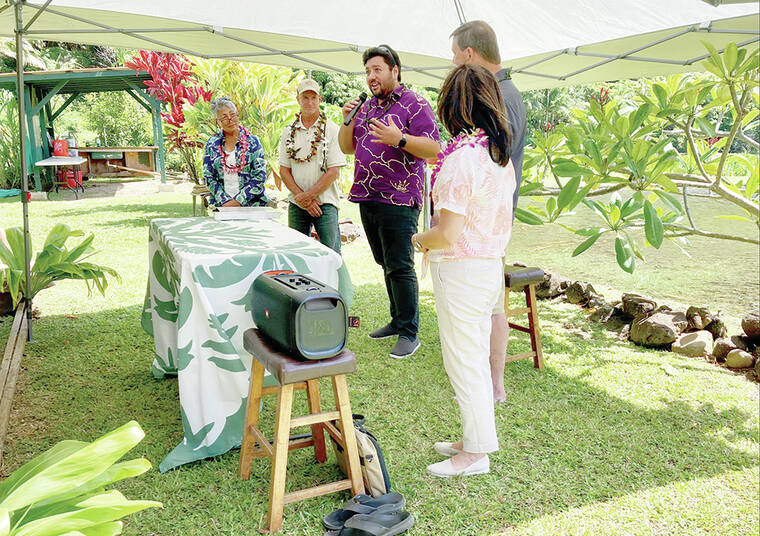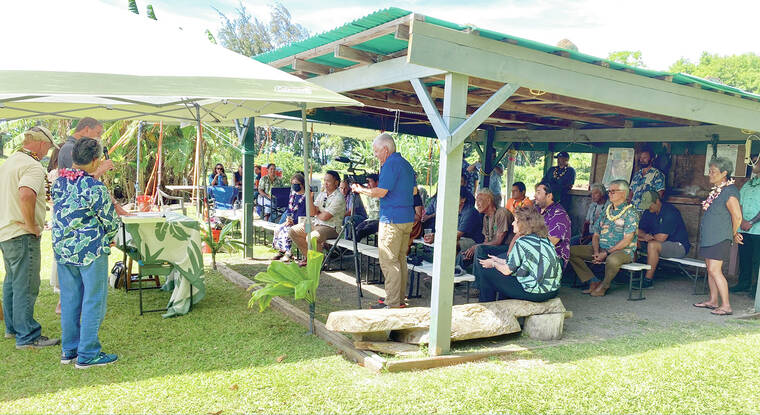HA‘ENA – The state Department of Land and Natural Resources held a press conference at Ha‘ena State Park, where it unveiled a 63-page handbook detailing how state and county representatives have worked with community members to manage the once “overcrowded, overtaxed, and over-loved” park.
In attendance at the event on June 8 were several government officials, including state Rep. Nadine Nakamura, state Board of Land and Natural Resources Chair Dawn Chang, DLNR Division of State Parks Administrator Curt Cottrell, Kaua‘i Visitors Bureau Executive Director Sue Kanoho, Hawai‘i Tourism Authority Public Affairs Officer Ilihia Gionson, and Chipper Wichman, a founding board member of community group Hui Maka‘ainana o Makana.
The 63-page document titled, “The Transformation of Ha‘ena State Park,” describes the 65-acre park as overrun and underregulated prior to 2018. The park is located at the end of the Kuhio Highway on Kauai’s North Shore.
It was previously the third-most visited state park, with over 700,000 visitors per year and 2,000 to 3,000 visitors per day. But its popularity as a tourist destination created a range of issues, including pushing locals out, lack of parking availability, trampling fragile resources, increasing waste along Napali Coast, and depleting fisheries, according to the document.
The state addressed those issues in 2019 with the approval of the Ha‘ena State Park Master Plan, which implemented an out-of-state visitor reservation requirement, a shuttle system, and a policy allowing only Hawai‘i residents to park in the main parking lot without a reservation.
The plan reduced the number of daily visitors to a targeted count of 900 per day, and made a commitment to “ensuring that there would always be room for residents to enjoy the park,” the document states.
As of 2020, the park’s rules for nonresidents include a $5 entry fee, a $10 parking fee, and a $35 shuttle fee. A percentage of the revenues generated by those fees goes toward managing the park’s landscape and cultural resources.
During the press conference, Chang called the document the “model” and “playbook” for “not only destination management, but true community economic self-sufficiency with cultural integrity.”
“You recognize what needed to be done, but you did it in the spirit of finding balance. And that’s what we’re trying to do at DLNR,” said Chang, adding that the department embraces the opportunity to utilize the Ha‘ena model for other areas.
Nakamura, who represents Kaua‘i’s North Shore and portions of the east side, said she hoped the handbook would serve as a springboard for future conversations surrounding scaling other hotspots throughout the state.
“And that’s the exciting discussion ahead of us that we all need to be a part of,” she said.
Gionson, who previously called Ha‘ena State Park “a model for destination management,” thanked Nakamura for her work on the project, and emphasized the importance of “regenerative tourism” in Hawai‘i.
“Yes, our economy is very dependent on the $211 million that visitors spent in April 2023 here on Kaua‘i. And, yes, that comes with the burden of hosting 27,000 visitors on any given day. But it’s not the 27,000 you see, it’s the 27 in front of you making the traffic,” he said.
Cottrell said the state is working toward a similar reservation and destination management system at 10 other state parks.
“There isn’t a timeline in mind,” said Cottrell. “We’re doing destination management pretty much one park at a time, methodically and slowly. And that’s why it’s working,” he said, adding the state has spent years collecting data on parking, transportation and other capacities.
Gov. Josh Green was also at Ha‘ena State Park just prior to the conference, where he held a signing ceremony for a bill that aims to reduce the impacts of over-tourism at popular state parks. The bill, now Act 72, went into effect upon Green’s signature.
•••
Emma Grunwald, reporter, can be reached 808-652-0638 or egrunwald@thegardenisland.com.




Love that they did this. Last time we drove from Lihue to visit it was so much nicer. Beach at Ke’e was wide open, few people in the water, less trash on the beach and trail. So nice as resident to be able to enjoy it once again.
Nice job. Now all those displaced tourists are in front of my house. Crappy parking, no lifeguard, no toilets. One drowned a few days ago.
Unintended consequences of short sighted polititians. Just wait until those other 10 parks displace tourists in front of your favorite zone.
You do realize this park plan had no public hearing due to the “flood emergency”. Some see it as a land grab by the self appointed elite. Let’s be more careful next time.
With respect to attempts to be a better steward of an irreplaceable resource, non-residents can’t possibly cope with waking up in the middle of the night, as they currently must, exactly 30 days ahead of a visit, to do what they’ve always done for years, all while paying an exorbitant price for something that is nominally public land (parks). If you do too much of this, you’ll have islands without tourists, which of course is what many of the ‘haves’ in the north shore want, a private island. This can’t be good, long term, for residents and advocates for the land and the people of Hawaii, Kauai, or the north shore. This isn’t the model. And if you are going to do this then get your digital act together and pay attention to when and what you’re asking people to do and how over-managed a vacation quickly becomes. This is so out of touch with a reasonable approach to this.
It’ll be really nice when DLNR addresses the chaos in Wailua River. Because there apparently no rules, commerical kayak and SUP rental and tour companies without any kind of permits continue to operate.
Not so fast……because access to Ha’ena is free to residents, which means residents don’t have to deal with going online at 12 AM, paying for parking, paying for access, or have to deal with the shuttle, doesn’t mean “this is the greatest run park on Earth”.
The park went from a “free for all”, craziness, to restricting 900 people a day. Not sure how the 900 a day was created, but you could probably add another 400 a day, and not miss a beat. Even in the prime of summer June-August the trail and the beach has few people. It’s nice, but God forbid you have your own “guests”, “Friends”, etc. visiting, and want to get a reservation online. The online process is painful, because of the limit of 900 people. The reservations are sucked up quickly. I’d love to see some comments from regular visitors to Kauai.
Again, if you are a resident, then you don’t care. Facts sting.
No money is made. Tourist are down. Why would anyone pay for park fees. It’s not a good thing. Regardless what locals think, park fees will not cut it and no money made on this deal. Some other way.